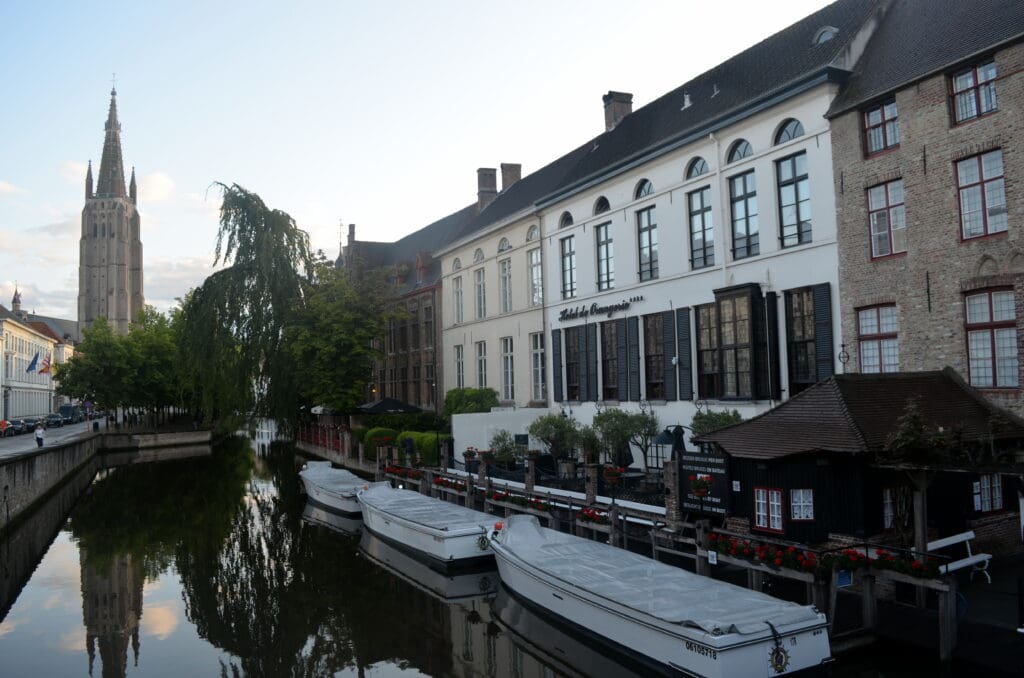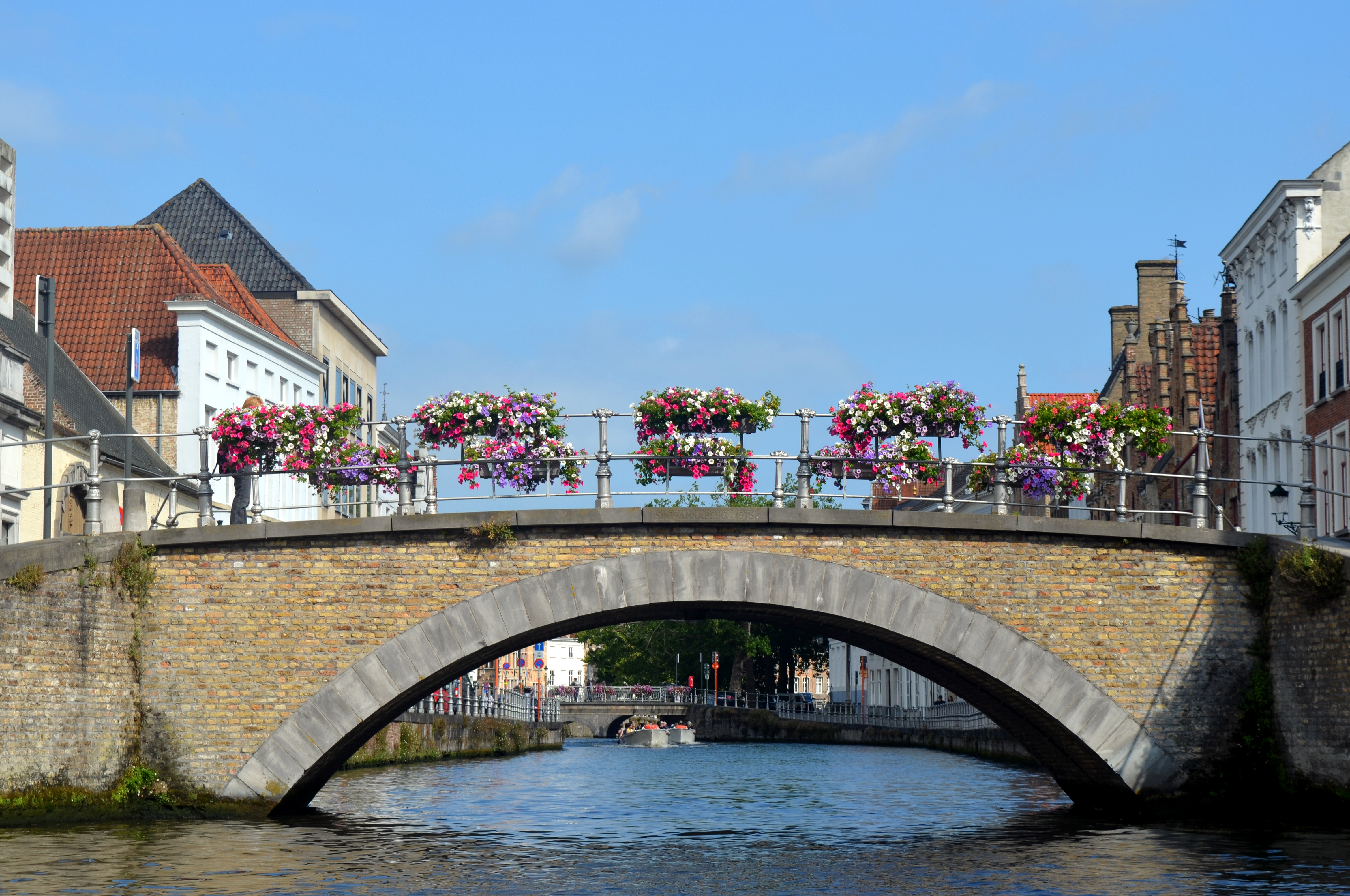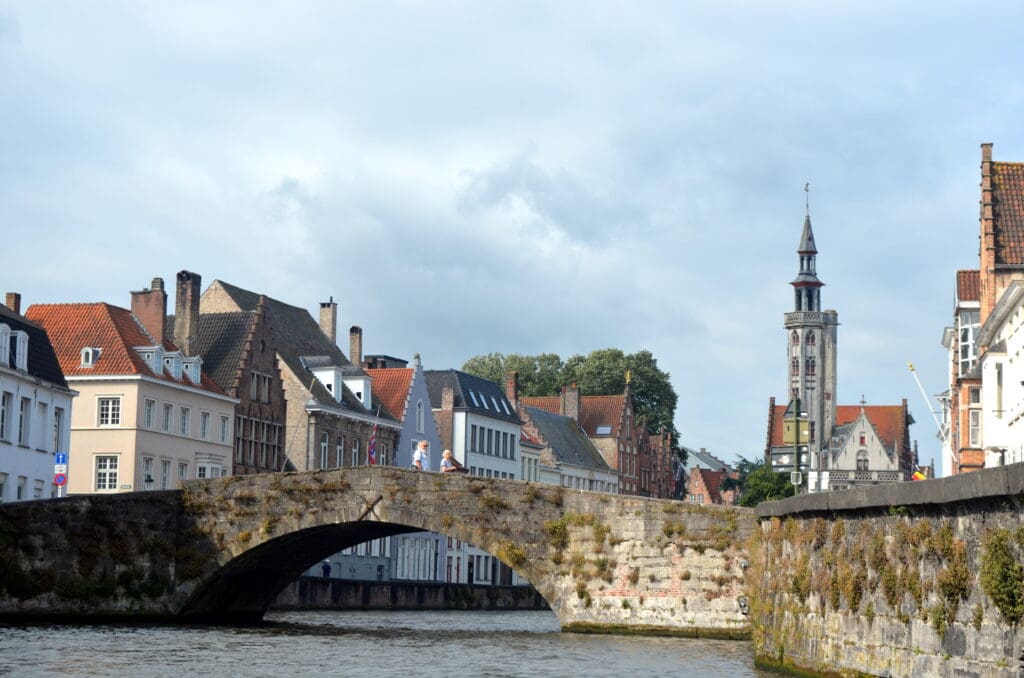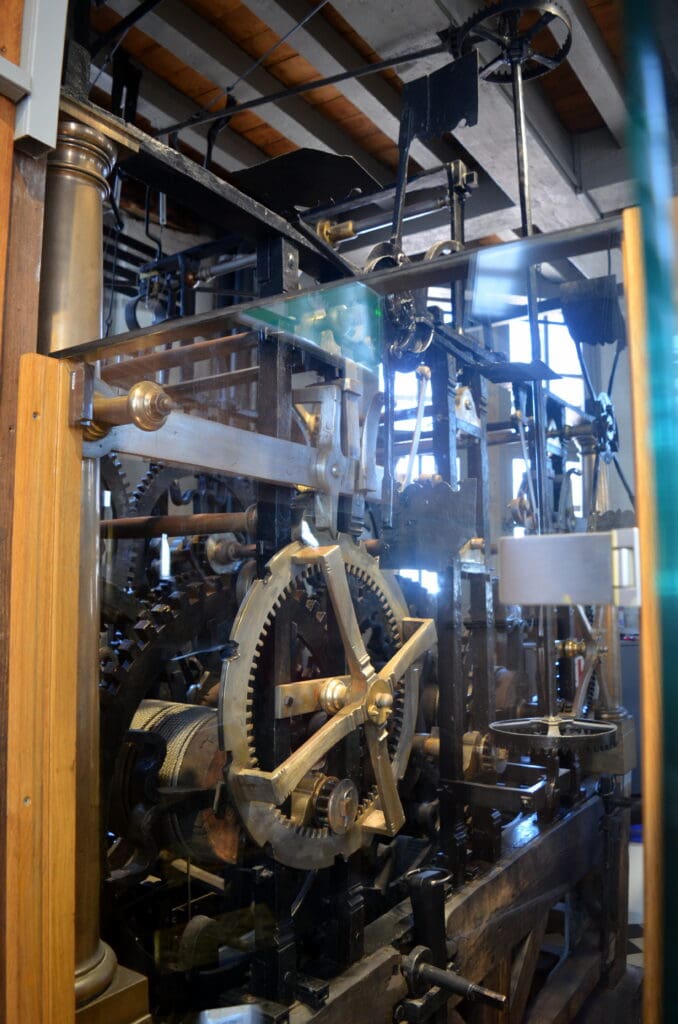On Monday, we took the Eurostar train from London to Brussels, Belgium retracing our journey from April, but in reverse. After a half hour delay, we departed London around 1:30pm for the two-hour trip to Brussels. From there, we boarded an intercity train to Bruges, about an hour away.
It was raining lightly when we arrived, and we had to haul all of our bags from the train station to our hotel, Hotel Dukes’ Palace Bruges. We joked that we are probably not their usual clientele, as most guests with this many bags probably arrive by taxi or private car.

Kurt immediately got to work after we checked into the hotel since he will be working remotely while we are here (4pm-midnight local time). Meanwhile, I went to pick up some groceries at a supermarket nearby, Proxy Delhaize, which had a good selection of gluten-free items. With a break in the rain after eating a quick dinner of sandwiches at the hotel, I decided to venture out and get my bearings around the city center while Kurt conducted his work meetings. Even though sunset wasn’t until around 10pm, there were minimal people out and about in the evening (which allowed me to get some photos of the primary highlights around the city without the crowds).
On Tuesday, I showed Kurt around where I had briefly explored the night before. Our first stop though was lunch at De Hobbit, Kurt’s choice. Although the restaurant didn’t feature specific gluten-free options, I had “The Hobbit” salad, which is the chef’s choice and a surprise each time. Kurt got surf ‘n turf, and a Belgian beer, of course. Highly recommend!

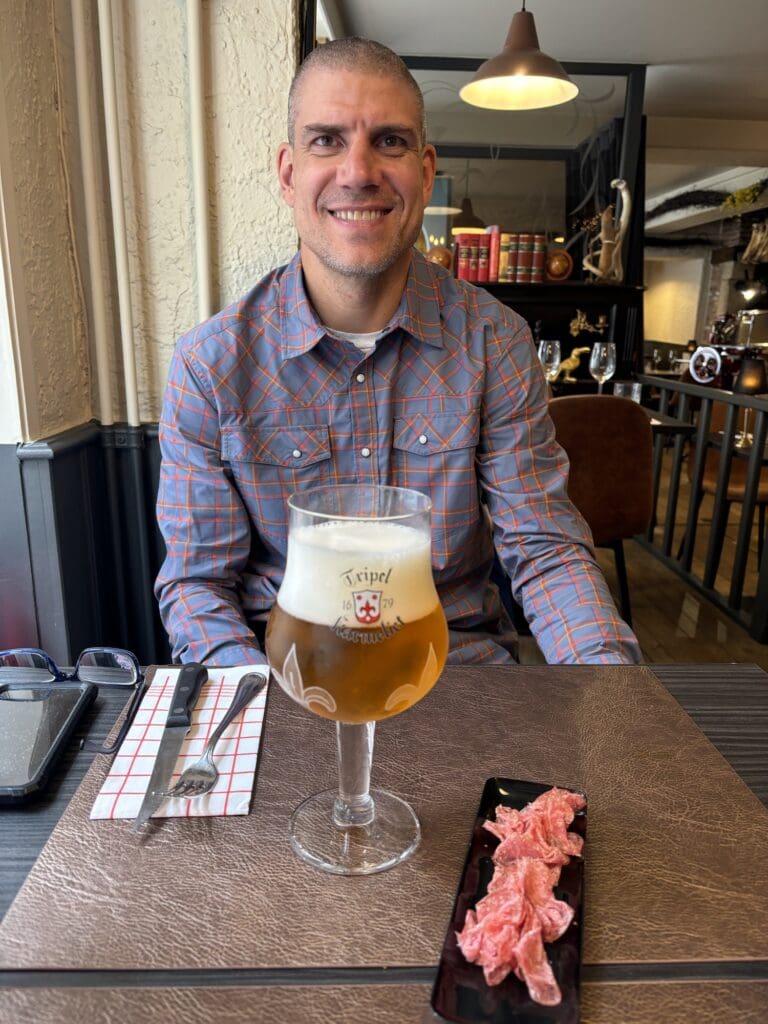

Fueled up from lunch, now we were ready for some sightseeing. First up was a visit to Onze-Lieve-Vrouwekerk (Church of Our Lady). While a visit to the Church is free, half of it is accessible only with a paid “museum” ticket (8 Euro). The featured attraction of the “museum” is a sculpture by Michelango (more on that in a bit).
Like many churches in this part of Europe, this one started as a Romanesque building that was probably built in the 9th century, but only a foundation wall remains from that period. The Gothic rebuild began in the 12th century, first with the nave and then additional chapels with the high arched ceilings, tall spires and pointed windows characteristic of the French Gothic style. Later on, the interior was renovated, and the walls were repainted white, covering up the colorfully painted walls common in medieval churches which were found during a restoration that took place from 2012 to 2020.


Given our sightseeing plans for our time here, we decided to purchase the Musea Brugge Card (33 Euro includes admission to specific monuments and museums for 72 hours). So, we left the Church with plans to return to the “museum” later that afternoon, and we went to purchase the Museum Card from the Groeninge Museum. To our surprise, there wasn’t a line to enter and there were minimal visitors inside.
The museum is organized into ten rooms, each one featured an information card about the paintings in that room and selected ones are denoted as “Flemish Masterpiece” so that you can easily identify the ones that are significant (which I appreciated). Kurt also listened to the free online audio tour with my phone for even more information. This is definitely an art museum that should not be missed!

Here are a few of the pieces that I enjoyed with the information provided by the museum:
Jan van Eyck – Madonna with Canon Joris van der Paele

The Bruges canon Joris van der Paele commissioned this work for a place beside his grave in St Donatian’s Cathedral, where he also asked for masses to be read. His patron saint, Joris (George), commends the sick canon to Mary and Jesus. Opposite them stands St Donatian, the patron saint of the church. Van Eyck’s detailed realism and rendering of material are astonishing, as are the reflections on saint George’s armor and helmet. The church interior is possibly based on St Donatian’s Cathedral, which no longer survives.
Jan van Eyck – Portrait of Margareta van Eyck

‘My husband Johannes completed me in the year 1430 on 15 June / I was thirty-three years old’, we read in Latin on the frame. This is followed by Jan van Eyck’s motto: ‘Als ich can’ (to the best of my ability). Van Eyck’s wife fixes us with a penetrating stare. Her clothing is trimmed with squirrel fur, while her horned hairstyle decorated with lace. After Jan’s death, she continued to run his Bruges workshop for a number of years.
Antonius Claeissens – Mars, surrounded by the Arts and Sciences, conquers Ignorance

Mars, the god of war, tramples ignorance, while Victoria, the goddess of victory, places a laurel wreath upon his head. They are surrounded by personifications of the seven arts and sciences. To the left are: Grammar (book), Geography (compass and globe), Astronomy (heavenly sphere), Rhetoric (caduceus) and Dialectic (parrot); whilst to the right are Music (shawm) and Arithmetic (wax tablet). Painting (palette and brushes) is walking towards the group. She claims her place among the Liberal Arts, which illustrates a contemporaneous 16th century debate.
René Magritte – The Assault

A wooden floor, a black wall with an opening that offers a view of a residential tower block. On the floor is a beam that resembles a cloud-filled sky, a grooved sphere and a frame containing a realistically painted female torso. What do these things have in common? Magritte enjoys wordplay and the title only serves to deepen the mystery.
Then, we went back to Church of Our Lady to visit the “museum” section. As mentioned, a chapel is said to have stood on this site before 900 CE. In the centuries that followed, this impressive gothic edifice, with the second tallest brickwork tower in the world, was built here. The church survived fires and was even publicly auctioned during the French Revolution. Throughout this time, the church continued to be a house of prayer and a final resting place for several prominent citizens of Bruges. Anxious to secure their place in the afterlife, they praised God with tomb paintings, memorial scenes and altarpieces, which they commissioned from the best artists. The many highlights of the church museum include Michelangelo’s Madonna, the prayer chapel of Lodewijk of Gruuthuse, and the tombs of Mary of Burgundy and her father Charles the Bold.
Around 1270, it became customary in Bruges to paint the inside of brick-lined graves. The scenes show what medieval people thought about the afterlife. The Virgin and Child are usually depicted at the foot end: she intercedes with God on behalf of the deceased. The crucified Christ is portrayed at the head end, bringing redemption to humanity through his death. On the side walls, angels with incense burners accompany the deceased’s soul to heaven. In the Middle Ages, the dead were often buried the same day they died, so the tomb painter had to work quickly. Crouching in the grave, he painted freehand on the wet, quick-drying lime. As a result, the drawings are quite rudimentary. In the 15th century, graves were no longer painted, but they were decorated with drawings on paper instead.



The Madonna with Child is the first of only a few works by Michelangelo to leave Italy during his lifetime. The Mouscron brothers, from a family of wealthy Bruges cloth merchants, ordered the work by Michelangelo for the considerable sum of 100 ducats, the equivalent to a year and a half’s wages for an artisan at the time. In 1514, Jan Mouscron and his wife donated the statue together with a new altar to the Church of Our Lady. Some members of the Mouscron family are interred at the foot of this altar.
Archival sources have confirmed that the statue should never be moved. During the French Revolution, the Madonna was confiscated and taken to Paris, but following Napoleon’s defeat at Waterloo, the statue returned to Bruges in 1816. During the Second World War, the Madonna was looted for a second time: now, Hitler wanted it for his great museum in Linz. The allies, known as the Monuments Men, rescued the statue, together with many other precious artworks, from the salt mines of Altaussee in Austria. Does this story sound familiar? It was brought to the big screen in George Clooney’s 2014 film ‘The Monuments Men.’


After an afternoon of art and history, we each went out for an evening run on the outer canal loop around the city (around 6 miles), passing through four gates that marked the historical entrances to the city.




We started off Wednesday with a canal tour by boat in the morning. There are multiple departure points around the city, so we just picked the boat company closest to us for the thirty-minute tour around (under) some of the 46 bridges in Bruges (15 Euro).
Once our brief boat tour was complete, we walked over to the nearby Gruuthusemuseum (included with the Bruges museum card), which is essentially a city palace featuring various historical objects. The highlight for me was the private upper chapel that is connected to the Church of Our Lady next door. This allowed the Gruuthuse family to attend mass without having to leave their palace.
Then, it was time for lunch at ‘T Schrijverke located across from the museum & Church. The unique menu drew Kurt in – he had rabbit stew and I had mussels with curry. We were able to grab a table outside before the restaurant filled up quickly after we arrived.


After lunch, we had intended to climb to the top of the 83-meter-high Belfort via its 366 stairs. However, due to the two-way nature of the narrow, winding staircase, entry is limited to 49 people inside at a time (entry and exit are electronically monitored to maintain the proper crowd size). As a result, we had to make a timed reservation (free; entry in 20-minute increments) for later that afternoon. So, we explored some of the other nearby buildings first, including the Basilica and Stadhuis (City Hall; included in the Museum Pass).


Given that the city hall is a working government office building, only the Gothic Hall on the second floor and the historical room next door to it are open to the public (the city council still meets here). The walls of the large room are covered with murals that tell the history of Bruges and beautiful stained-glass windows.




Then, it was time to head back to the Belfort for our timed reservation. Belfries are typically found in Flanders, Northern France, and in parts of Wallonia, in the south of Belgium, and they have relatively recently been added to the UNESCO world heritage list.
Historically, the way in which the bells were rung (ringing, chiming or tolling) inferred a different meaning to the signal. The combination of pitch and the time of day enabled the city’s residents to interpret the signal. For example, one important bell was the work bell, which marked the start of the working day. The noon bell was also known as the ‘papklok’ in Bruges (time to break for lunch or pap). The city gates were closed after the ringing of the evening bell. Today the belfry and its carillon continue to be relevant for Bruges, both for the city’s inhabitants and for tourists visiting the city. The automatic chime, on the quarter of the hour, is one of the sounds that is frequently identified with the city.
The carillon is and continues to be an impressive instrument. Its sound can be heard across the city and the ingenious system which is used to operate it continues to appeal to people’s imagination. On the one hand the carillon is similar to a music box. The drum, a round cylinder with pins or nootjes, is connected to the clock. Each pin can lift one hammer, thanks to levers and cables, which is positioned on the outside of the bell. On the other hand, the carillon can also be played with its keyboard, consisting of pedals and wooden batons. The batons are used to move the clappers against the bells.
The drum plays a melody on every quarter of the hour; every half quarter is indicated with a short musical signal. The music is changed every two years. The current music playing on the automated drum from Easter 2024-Easter 2026 is: “Somewhere over the rainbow” by Harold Arlen on the hour, “L’homme armé by Anoniem at :15, “Twee Meisjes” by Raymond van het Groenewoud at :30, and “Frank en Wimmie” by Karel Distelmans at :45.
While Kurt was interested in learning all about the 47-bell carillon, I was more interested in seeing the views of the city from above. Will climb for views!





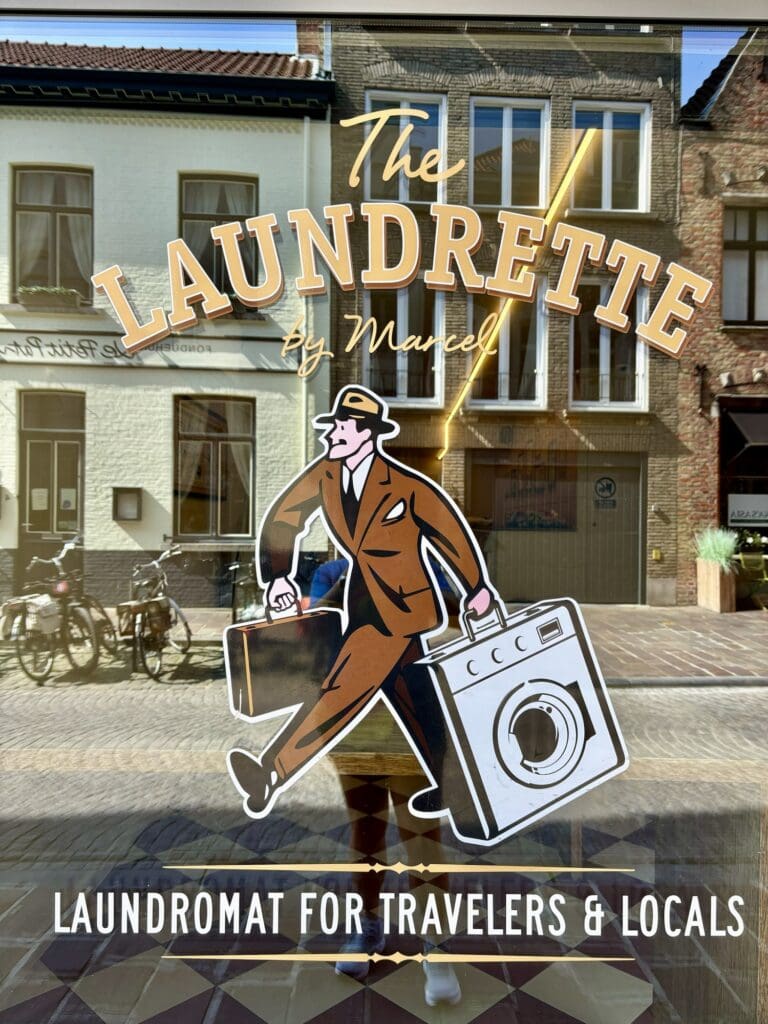
With our sightseeing done for the day, it was time for Kurt to head back to the hotel for work, while I took care of doing laundry and restocking some of our groceries before leaving for Switzerland tomorrow where things are more expensive. Not all parts of travel are glamorous!
Overall, Bruges met our needs well for this portion of the trip, as we needed an intermediate stop between London and Switzerland where Kurt could work for a few days. We were able to get a nice hotel without paying too much, and there were some things to explore without us feeling overwhelmed to pack our days full before Kurt worked in the evenings. While the relatively compact city center was bustling by late morning through the afternoon (likely with tour groups and daytrippers from Brussels or cruise ships), it was fairly empty in the evening. Being only an hour train ride from Brussels, it would be easy and worthwhile to do a full day or overnight excursion as part of an itinerary through that part of Europe.
Enough of the flat land and cities for us though for now. Off to the mountains we go!






